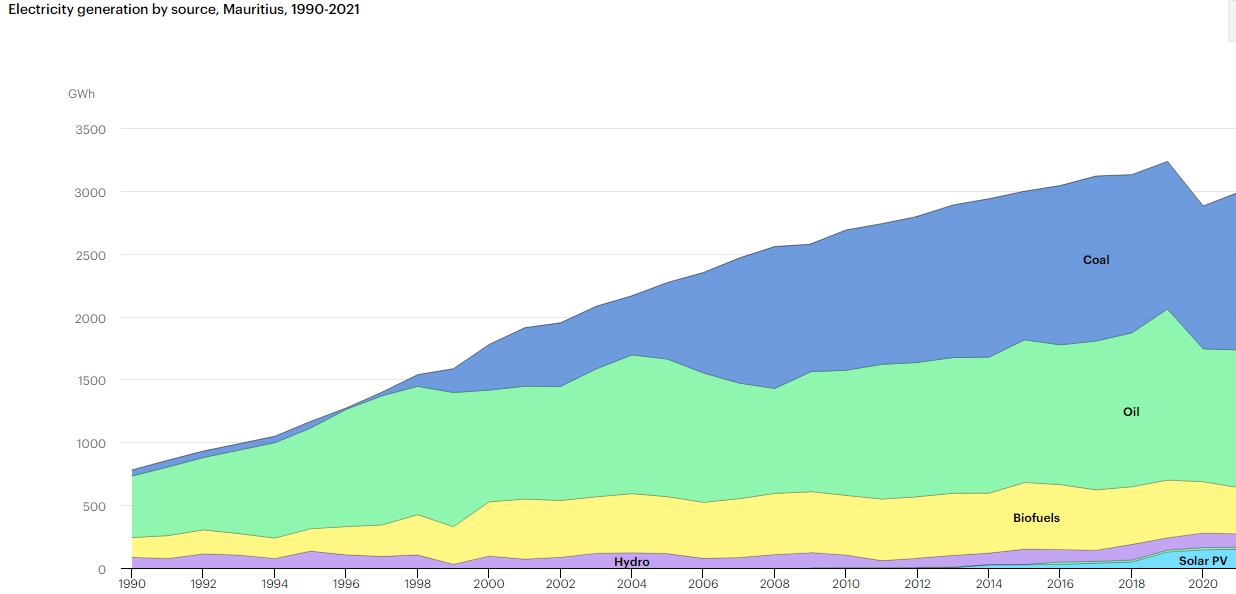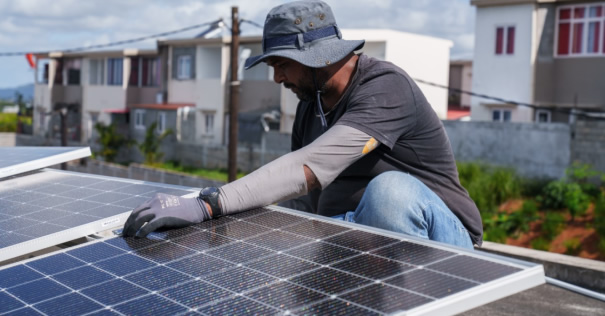PV column
Photovoltaic
2024/03/21
Residential roof-top PV project in Mauritius
Mauritius, an island country in the African Indian Ocean, has a population of approximately 1.2 million on its main island, which is about the same size as the main island of Okinawa, and the main island is approximately 2,040 km2 in size, about 1.7 times the size of the main island of Okinawa (1,207 km2).
As Mauritius is a sugarcane producing country, three types of thermal power generation facilities (coal, oil and bio-generated power derived from ‘bagasse’, the residue of sugarcane after pressing) account for about 90% (2717 GWh of the country’s annual electricity production of 2989 GWh in 2021 was thermal power). Also in this respect, the composition is similar to that of Okinawa, which has no nuclear or large hydroelectric power stations and is based on thermal power stations.
Graph 1. Electricity generation by source, Mauritius:

**********

Home Solar Project Reduces 2,000 Mauritian Households’ Electricity Costs and Carbon Emissions
25 January 2024 Articles
The Central Electricity Board (CEB), under the Ministry of Energy and Public Utilities of Mauritius, has made significant strides in scaling up the deployment of solar (photovoltaics) PV systems under the Home Solar Project (HSP) scheme. The initiative is made possible through concessional funding from Abu Dhabi Fund for Development (ADFD), which has availed USD 10 million to the project under the IRENA/ADFD Project Facility, covering half of the project total costs. CEB provides the rest of the financing.
Recognising the suitability of rooftop solar PV for Mauritius as a Small Island Developing State (SIDS), the socio-economic impact and climate benefits, ADFD and IRENA teams approved CEB’s proposal to install 10,000 solar PV systems on household rooftops across Mauritius.
This initiative aligns with Mauritius’ commitment to reducing fossil fuel dependence and decarbonising the energy sector. With a total capacity of 10 megawatts (MW) upon completion, the project is saving 15,000 tonnes of carbon dioxide equivalent and USD 400,000 per year while reducing the country’s reliance on diesel fuels.
“The first benefit we saw was the reduction in our electricity bills,” says Denis Trevedy, a resident of Dagotière in Mauritius. “When we saw it drop by more than 50%, it was really great. And when people heard about the savings we were making, everyone was interested.”
The project is in line with the government’s efforts towards social and economic development, whilst contributing to the targeted share of 60% electricity from renewables by 2030. As an incentive to host CEB’s solar module, each household receives a free baseline consumption, decreasing the electricity charges. The generated electricity, which is left unconsumed, is injected into the grid.
“The solar power has considerably reduced our electricity bills,” says Emilie Lacharmante, a project beneficiary living in Petite Julie. “It has enabled us to buy more groceries. We’ve been able to make enough for the month, completely.”
The project focuses on bringing rooftop solar modules to social housing developments. The solar panels are provided and installed free of charge for the beneficiary households. To enhance awareness and encourage participation among eligible households, CEB has executed a successful outreach programme and awareness campaign, which resulted in the installation of solar systems for 2,000 households.
Together, ADFD and IRENA have selected 26 clean energy projects in 21 countries across Asia, Africa, Latin America, and SIDS. The IRENA/ADFD Project Facility encompass a wide spectrum of technologies and renewable energy sources – wind, solar, hydro, geothermal and biomass. Estimated to generate a total capacity of 245 MW, those projects can fuel the needs of more than 4.5 million households and businesses in the different regions.
**********
For an overview of the energy situation in the country of Mauritius, please follow the link to the website of the United States Department of Commerce, Bureau of International Trade, April 2023.
Link: Mauritius – Energy (trade.gov)
We expect that the approach to the installation of photovoltaic system in Mauritius, with its size, population, type of power generation sources and location as an island nation, will serve as a reference for Japanese prefectures and municipalities in installation renewable energy with the aim of CO2 reduction the country.

